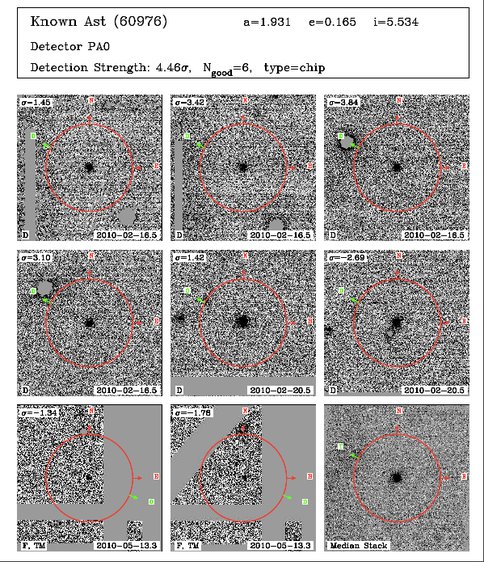2010 Annual Science Report
 University of Hawaii, Manoa
Reporting | SEP 2009 – AUG 2010
University of Hawaii, Manoa
Reporting | SEP 2009 – AUG 2010
PanSTARRS MBC Stamp Server and Searching for Main Belt Comets
Project Summary
We have been developing the architecture to search for activity in moving objects
discovered with the new Pan-STARRS1 all sky survey, and in particular to look
for volatile-driven activity in the new class of objects, called Main Belt Comets.
The survey facility is now operational and we are starting to do the first big processing
of the datasets.
Project Progress
Searching for Main Belt Comets with the Pan-STARRS 1 Survey Telescope
The Pan-STARRS1 (PS1) project is an all-sky survey using a 1.8-meter telescope on Haleakala in Hawaii. We have developed a system (“stamp store”) for storing and archiving intermediate static-sky subtracted images for transient detections, like asteroids. Normally, these images would be deleted, but we need them to apply specialized photometry to search for comet-like activity. This system will archive and organize approximately 40 terabytes of data over the 3.5-year lifetime of the project. Our approach for searching for MBC activity is based on searching for the brightest segment around a point source, and it is incorporated into a data processing pipeline that automatically polls new PS1 asteroid detections, performs specialized photometry on images in the above stamp store, and accumulates statistics used in deciding whether an object is an MBC candidate.
We have been engaged in a search for more Main Belt Comets (MBCs) in data from the newly operational Pan-STARRS1 (PS1) survey telescope on Haleakala. This is the first year that PS1 has been running steadily, producing terabytes of image data and hundreds of thousands of asteroid detections. Using our specialized pipeline, we have been analyzing Main Melt asteroid detections for signs of cometary activity (see Figure). We have found what appears to be a statistical excess of activity in the expected direction as opposed to unphysical directions. Over the next year, we will continue mining PS1 data and following up candidates with time on other telescopes, for which we have significant allocations. Using our specialized pipeline designed to search postage stamp images of asteroids for tail activity, we have been analyzing Main Melt asteroid detections for signs of cometary activity (see figure). In a preliminary batch of data from the spring of 2010, we have found what appears to be a statistical excess of activity in the expected direction as opposed to three unphysical orthogonal directions, yielding 5 to 10 potential MBC candidates. Over the next year, we will continue searching PS1 data, improving and extending our search algorithms. We will also follow up candidates with time on other telescopes, for which we have been allocated 14 hours of CFHT time, 6 nights of UH 2.2m time, and 6 nights of SMARTS 1.3m time. In deeper exposures, we hope to see direct evidence of activity that was detected statistically in PS1.
This project will eventually yield a full measure of the MBC population, will help determine the prevalence of water in the inner Solar System, and will provide likely provide targets for possible NASA missions to visit these bodies.

The University of Hawai’i's Pan-STARRS 1 telescope on Haleakala Maui has a 1.8-meter
primary mirror, and an extraordinary field of view – six times the width of the full Moon.
The first light of PS1 was on May 13, and the telescope exploits the combination of a
superb observing site and unique new technology for an extensive all sky survey.
“Postage Stamps” of moving objects (asteroids) from the PS1 telescope. The grey areas are regions where there is missing or filtered data. As the static sky gets built up, there will be significant improvement to the background subtraction, and from these we will be searching for dust as indicators of low levels of activity.
-
PROJECT INVESTIGATORS:
-
PROJECT MEMBERS:
Karen Meech
Co-Investigator
-
RELATED OBJECTIVES:
Objective 1.1
Formation and evolution of habitable planets.
Objective 2.2
Outer Solar System exploration
